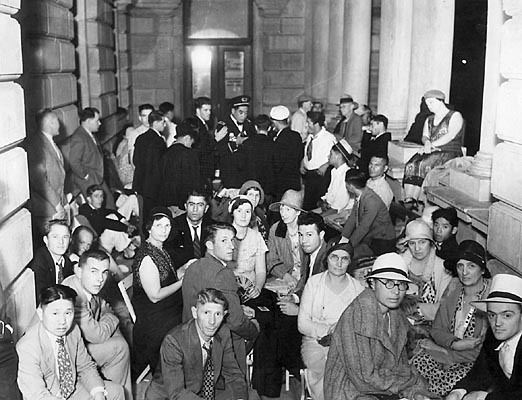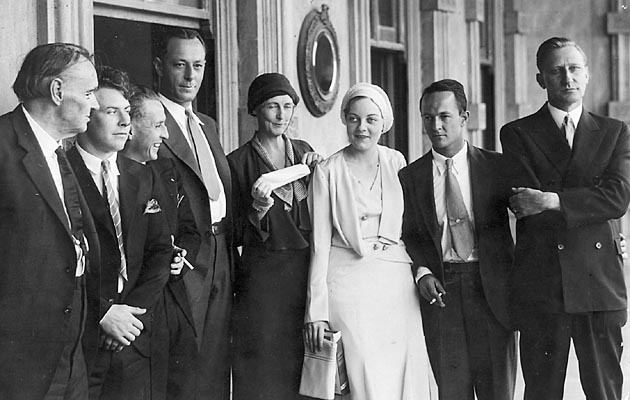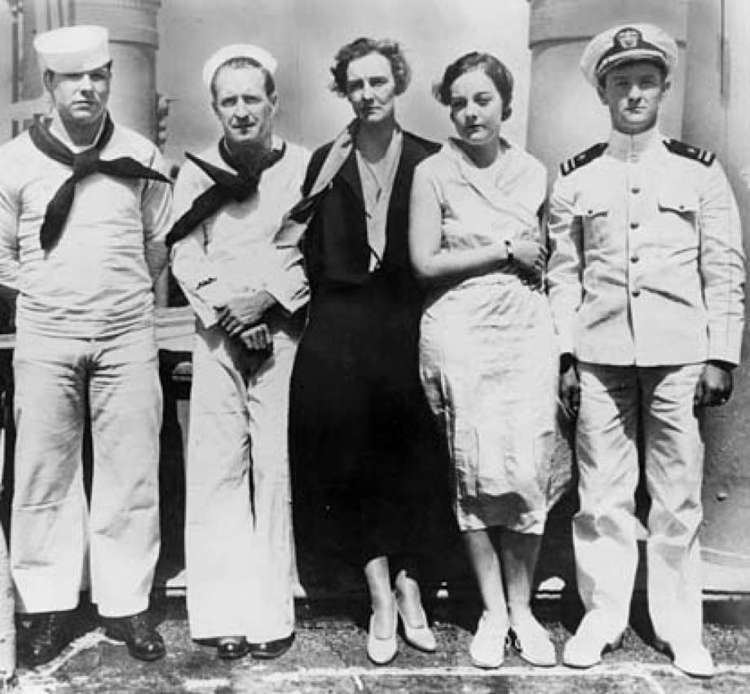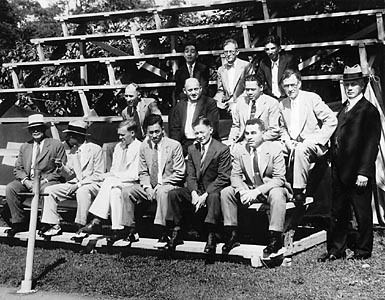The Massie Trial for what was known as the Massie Affair, was a 1932 criminal trial that took place in Honolulu, Hawaii. Grace Hubbard Fortescue, along with several accomplices, was charged with murder in the death of well known local prizefighter Joseph Kahahawai. Fortescue was the mother of Thalia Massie, who had brought charges that Kahahawai was one of a group of men that had raped her.
Contents
- Background
- Territory of Hawaii v Ben Ahakuelo et al
- Territory of Hawaii v Grace Fortescue et al
- Pinkerton investigation of the Ala Moana case
- In popular culture
- 2006 mock trial
- References

Background

Grace Hubbard Fortescue, née Grace Hubbard Bell, was the granddaughter of Gardiner Greene Hubbard, the first president of the National Geographic Society, and niece of Alexander Graham Bell. Her marriage to Major Granville "Rolly" Fortescue, an out-of-wedlock son of Robert Barnwell Roosevelt, did not leave her as financially successful as she would have wished, but she nevertheless kept up appearances and raised her daughter Thalia with an American upper class lifestyle.

Thalia Fortescue married Lieutenant Thomas Massie, a rising United States Navy officer. In 1930, Massie was stationed at Pearl Harbor, where Thalia considered herself "above" the rest of the officers' wives and soon became an outcast. The marriage, apparently not terribly successful to start with, degenerated into heavy drinking and public fights.
On September 12, 1931, the couple attended a Navy event at the Ala Wai Inn, a Waikiki nightclub. Thalia had another argument which ended with her slapping an officer and then storming out. Massie, not having witnessed the event, assumed she was tired and had gone home.
Territory of Hawaii v. Ben Ahakuelo et al.

Massie eventually tried to call his wife to make sure she had arrived safely—after several calls Thalia finally answered, but in a state of shock. Massie returned home and heard from Thalia that while walking home she had been assaulted and raped by several Hawaiian men. Over Thalia's objections, Massie immediately phoned the police, who arrived to take her statement. Initially she could not provide any details at all, stating that it was too dark to identify any of the men or to see any details of the car they emerged from.
Several hours later the story changed. Thalia now not only described the assailants as "locals", but gave police a license plate number. Within hours the police arrested Horace Ida. Ida was not entirely surprised at first, as only a few hours earlier he had been involved in a near collision while driving his sister's car. Although there was no damage, an argument broke out with the other driver and one of his friends, boxer Joseph Kahahawai, slugged the woman. Upon his arrival at the police station, the charges with the altercation were never brought up—instead he found to his dismay that he was being charged with rape.

At first glance, the story seemed to hold water. Thalia's license plate was off by only one digit (or letter) and her description of the men, Ida and his friends, was fairly accurate. However, it later became known that the police taking Thalia's statement had in fact "told her" both pieces of information, apparently after hearing the name and description from the initial complaint filed by the woman driver. Riccio offers the following account of the incident involving Horace Ida:
Horace Ida, a young Japanese man, had borrowed his sister's two-year-old car and had attended a luau accompanied by his pals Joe Kahahawai, Benny Ahakuelo, David Takai and Henry Chang. At about 12:30 A.M, Horace suggested they call it a night. He and his friends piled into the car and left the luau.
As the car passed through an intersection in downtown Honolulu, Horace barely missed colliding with an automobile coming from the opposite direction. There was no contact between the two cars, but both drivers stopped and everyone piled out to argue the fine points of Hawaiian motor vehicle law.
The occupants of the other car were a Mr. and Mrs. Peeples. Mrs. Peeples was voicing her opinion of Horace Ida's driving skills when Big Joe Kahahawai (all six feet and more of him) hauled off and punched her in the face. Mrs. Peeples was equal to the challenge. She gave as good as she got. She clenched her fist, wound up, and to Big Joe's surprise, slugged him in the mouth! The incident was about to become a donnybrook. However, cooler heads prevailed, and the Peeples drove off to the police station to report the incident.
At the station, the Peeples gave Horace Ida's license plate as 58-895, and the police put out an all points bulletin for the car and its occupants. At about the same time, the police learned of the rape in Ala Moana Park, so it was only natural that they would assume that the occupants of the Ida car were more than likely the perpetrators of the assault on Thalia Massie.
Horace Ida and his friends were eventually located through the car's license plate and were brought before Thalia at the police station. She was unable to identify Horace Ida, who was wearing a brown leather jacket when she saw him. When asked the license number of the assailants' car, she did not remember it, but she later heard the plate number 58-895 being broadcast at the police station.
Rear Admiral Yates Stirling, Jr., Commandant of the US Navy's 14th Naval District (which included the islands), indicated that his first inclination was to lynch the accused assailants, but that they must give "the authorities a chance to carry out the law and not interfere." In stories printed as the case developed, the local newspapers referred to the men as "thugs", "degenerates" and "fiends", while Thalia was described as "a white woman of refinement and culture".
As the case developed, cracks in the story immediately appeared. In order to have assaulted Thalia—an event so far unproven to have even occurred—it would have been extremely difficult to have then been involved in the near accident across town. Witnesses soon came forward who reported seeing Thalia followed by a white man only minutes before the alleged assault took place. This information was never reported in the trial that was to follow, nor was the fact that the police planted information. The police themselves were split on the case—many of the detectives were locals who saw the case was a sham and when they were denied access in the courtroom, they started to talk directly to the press.
Riccio:
While the good citizens of Honolulu waited for the trial to begin, rumors began to develop and spread through the city. There were those who whispered that Thalia had not been raped at all. It was said that she was having an illicit relationship with one of the five beach boy suspects, and that she was on her way to a rendezvous with him when she found him in the company of four drunken friends.
in flagrante delictoGrace Fortescue, enraged by the stories and what she saw as an attempt to sully the name of her daughter and the family, arrived and started a public campaign to attack the defendants. Admiral Stirling was worried that if the story reached the mainland he would be made to look as if he did not have control of the situation. The two groups successfully managed to keep the story out of the mainland press while the trial continued. Yet they also pressed the courts for a quick and aggressive prosecution to placate an enraged Navy.
In court the case quickly fell apart. After a three-week trial and lengthy jury deliberation, the jurors declared themselves deadlocked and a mistrial was declared.
Territory of Hawaii v. Grace Fortescue, et al.
Grace Fortescue was not willing to wait for another trial; she first arranged for the kidnapping and vicious beating of Horace Ida. Next, she talked Thomas Massie into kidnapping Joseph Kahahawai, the darkest skinned of the five defendants, with the help of two Navy enlisted men-Albert O. Jones and Edward J. Lord. Kahahawai underwent "interrogation", as Fortescue, Massie and the two Navy men attempted to beat a confession out of him—eventually, one of the group of four shot Kahahawai.
Debating what to do, they eventually decided to dump Kahahawai's body off Koko Head, at the time a desolate area far away from urban Honolulu. Although he would eventually be found, it seemed to them unlikely that anyone would care. They wrapped Kahahawai in a sheet and put him in Fortescue's rented car, pulling down the shades to hide the interior. A police motorcyclist, alerted to the kidnapping, saw the blinds and considered it suspicious. He pulled them over and immediately arrested all four for murder.
This time the story could no longer be kept under wraps. The mainland press soon started printing stories where "the roads go through jungles and in those remote places bands of degenerate natives lie in wait for white women driving by". The fact that the men had not been convicted of the alleged rape only proved to the mainland press that Hawaii itself was a hotbed of anti-white racial hatred, not that they were innocent. That Fortescue herself had actually admitted to the crime was insubstantial. Meanwhile, the tensions in Hawaii were ready to erupt into race riots.
Clarence Darrow, perhaps the most famous lawyer of his era, decided to take on the defense for the sum of $40,000. Darrow was brought out of retirement by Eva Stotesbury (wife of Edward T. Stotesbury), an old family friend.
Throughout the trial, Thalia attempted to present herself as an innocent victim. This fell apart when the prosecutor, John Kelley, played on her feelings of superiority. She became enraged, ripped up a piece of evidence, and stormed from the stand. Although this would seem to be a prosecution victory, the courtroom erupted in supportive applause from the spectators.
The jury returned a verdict of manslaughter rather than murder. Racial tensions were so high that everyone had expected another hung jury. The mainland press exploded with even more stories and the situation in Hawaii grew more tense. Martial Law was considered by Admiral Stirling if rioting were to begin, as he had considered imposing it from the start.
After a flurry of diplomatic maneuvering between Washington, D.C. and Honolulu, martial law was avoided. Instead, under pressure from the Navy, Territorial Governor Lawrence M. Judd commuted the 10-year sentences of the convicted killers to one hour, to be served in his office. Days later the entire group, including the Massies, the two other Navy men, Fortescue and Darrow, boarded a ship and left the island in turmoil. Thalia and Massie divorced in 1934; she committed suicide in 1963; he died in 1987. Grace Hubbard died in 1979. Albert Jones died on September 23, 1966. Edward Lord died in 1967.
In 1966, while being interviewed by author Peter Van Slingerland, Albert O. Jones admitted that he was the one who shot Joseph Kahahawai.
Pinkerton investigation of the "Ala Moana" case
Although the prosecution's lead witness, Thalia Massie, had left the Territory and could not be forced to return to testify, the four surviving Ala Moana defendants could not be exonerated immediately. As Peter Van Slingland wrote, "Congress, the Navy, and mainland public opinion would not allow the charges to be dropped without good reason." Before the subsequent dismissal of the charges, Governor Judd hired the Pinkerton's National Detective Agency to further investigate and to review the evidence. The Pinkerton agency responded with a 279-page report, in which the introductory letter stated:
An analysis of the reports of our representatives, together, with the reports and statements of the Attorney General's office, the office of the Public Prosecutor, and the Police Department, also the testimony at the trial of the defendants, makes it impossible to escape the conviction that the kidnaping and assault was not caused by those accused, with the attendant circumstances alleged by Mrs. Massie.
In popular culture
In February 1986, CBS-TV aired a four-hour miniseries produced by Lorimar Productions titled Blood & Orchids, written for television by Norman Katkov, who based his teleplay on his own novel of the same title. Though Katkov said that he based his novel on the Massie Affair, his novel and teleplay bear only a superficial resemblance to fact. Katkov changed all the names of the principal characters and added other characters for whom no historical warrant can be found (most notably, Police Captain Curtis Maddox, supposedly the one conscientious law-enforcement officer who ever investigated the affair). Katkov's story also departs significantly from actual events in many ways, such as making the murder of Kahahawai look like a crime of passion—and laying all the blame on Lieutenant Massie and not on Grace Fortescue.
Max Allan Collins's 1996 novel, Damned in Paradise, follows the facts of the case more closely than Katkov's book. An entry in his series about Depression-era private eye Nate Heller, Damned in Paradise casts Heller as the personal investigator for Darrow after the famed attorney is retained to represent Lt. Massie, Grace Fortescue, and the other defendants accused of Kahahawai's murder. Collins also includes fictionalized depictions of such historical figures as John Jardine, one of the actual Honolulu police detectives who investigated the case, and Chang Apana, the real-life inspiration for Charlie Chan, who was still an active-duty detective in HPD at the time of the Massie case (though there's no official record to suggest that Chang was actually one of the investigating officers). As is often the case in the Heller series, Collins provides an alternate solution as to who might have been responsible for Mrs. Massie's rape.
In his afterword to Damned in Paradise, Collins suggested that Robert Traver's 1958 novel, Anatomy of a Murder, was loosely inspired by the Massie case, involving, as it does, a military officer who murders the alleged rapist of his wife and the subsequent trial arising from that murder, with the setting changed from Honolulu to Michigan's Upper Peninsula, and the Naval officer changed to an Army officer. However, in 1952 Traver himself defended an Army officer accused of the murder of his wife's alleged attacker, and, despite the striking parallels to the Massie incident, it is more likely that this was the case from which Traver derived his plot.
The case was revisited in 2016 by Investigation Discovery's series A Crime to Remember (Season 4 Episode 4, "Paradise Lost").
2006 mock trial
During the American Bar Association convention at the Hawai'i Convention Center in Honolulu, on August 3, 2006, Lt. Gov. Duke Aiona served as the judge at the mock trial, using a copy of the Pinkerton National Detective Agency report compiled by the then Territorial Government and using 21st century forensic techniques, looked into the rape case once more. Lawyers attending the convention acted as the Jury.
After testimony from two experts, and new arguments about the case, the lawyers voted with a unanimous "Not guilty" verdict for all defendants. Among other deciding factors was the defense's evidence that the five men accused of the rape had been involved in violence on the other side of Honolulu (the near collision with the Peeples's car) near the time of the alleged attack on Massie and would not have been able to reach Waikiki in time to have also raped Massie as she described.
In a coincidental historical twist, the Hawaii Convention Center — where the mock trial was held — sits on the former site of the Ala Wai Inn, where the case first started.
